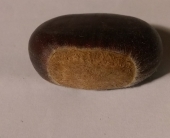posted 2 years ago
In my copse (an area of coppiced woodland) the regrowth on the trees is phenomenal - they reached 4' (1.2m) in the first year and are up at 7 or 8' (2.1-2.4m) now, in their second.
I can't imagine how the stools would cope if there were two competing for the same spot but I am sure the stool with the younger growth would be forced to grow sideways or wiggly, removing a lot of the utility of the wood.
I would suggest that you cut both the trees at the same time and, assuming similar rates of growth, both will grow slightly outwards and then up, towards the light, giving you straight poles with a curve at the bottom. That may be a useful shape in its own right (hockey sticks, brush hook/slasher handles) or you could trim off the curved sections for a straight rod for the usual uses.
I would also expect the two stools to show less vigour than the other, more distantly-spaced stools (assuming you have more trees cut for coppice). This might also affect your rotation a bit.
As Phil says, it can't hurt to try it.
Small-holding, coppice and grassland management on a 16-acre site.






